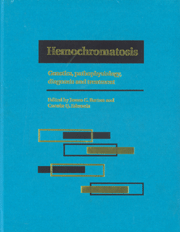Book contents
- Frontmatter
- Contents
- List of contributors
- Foreword
- Part I Introduction to hemochromatosis
- Part II Genetics of hemochromatosis
- Part III Metal absorption and metabolism in hemochromatosis
- 10 Intestinal iron-binding proteins
- 11 Intestinal iron absorption and hemochromatosis
- 12 The absorption and metabolism of non-ferrous metals in hemochromatosis
- 13 Ferritin metabolism in hemochromatosis
- 14 Hepatic iron metabolism in hemochromatosis
- 15 Extra-hepatic iron metabolism in hemochromatosis
- 16 Mathematical models of metal metabolism in hemochromatosis
- 17 Expression of iron overload in hemochromatosis
- Part IV Diagnostic techniques for iron overload
- Part V Complications of iron overload
- Part VI Therapy of hemochromatosis and iron overload
- Part VII Infections and immunity in hemochromatosis
- Part VIII Hemochromatosis heterozygotes
- Part IX Relationship of hemochromatosis to other disorders
- Part X Animal models of hemochromatosis and iron overload
- Part XI Screening for hemochromatosis
- Part XII Hemochromatosis: societal and ethical issues
- Part XIII Final issues
- Index
12 - The absorption and metabolism of non-ferrous metals in hemochromatosis
from Part III - Metal absorption and metabolism in hemochromatosis
Published online by Cambridge University Press: 05 August 2011
- Frontmatter
- Contents
- List of contributors
- Foreword
- Part I Introduction to hemochromatosis
- Part II Genetics of hemochromatosis
- Part III Metal absorption and metabolism in hemochromatosis
- 10 Intestinal iron-binding proteins
- 11 Intestinal iron absorption and hemochromatosis
- 12 The absorption and metabolism of non-ferrous metals in hemochromatosis
- 13 Ferritin metabolism in hemochromatosis
- 14 Hepatic iron metabolism in hemochromatosis
- 15 Extra-hepatic iron metabolism in hemochromatosis
- 16 Mathematical models of metal metabolism in hemochromatosis
- 17 Expression of iron overload in hemochromatosis
- Part IV Diagnostic techniques for iron overload
- Part V Complications of iron overload
- Part VI Therapy of hemochromatosis and iron overload
- Part VII Infections and immunity in hemochromatosis
- Part VIII Hemochromatosis heterozygotes
- Part IX Relationship of hemochromatosis to other disorders
- Part X Animal models of hemochromatosis and iron overload
- Part XI Screening for hemochromatosis
- Part XII Hemochromatosis: societal and ethical issues
- Part XIII Final issues
- Index
Summary
Introduction
Many non-ferrous metals are encountered as normal dietary constituents, environmental contaminants, or occupational hazards. However, the absorption and metabolism of non-ferrous metals and their relationships to that of iron are incompletely understood. Early investigators discovered that there is increased retention of certain non-ferrous metals in the liver, blood, or other tissues of persons with hemochromatosis. These observations indicate that increased absorption, altered transport and tissue and organ deposition, or abnormal excretion of the metals occur in hemochromatosis. Further, many Caucasians of western European descent have inherited hemochromatosis allele(s), and may have increased susceptibility to the deleterious (or beneficial) effects of increased non-ferrous metal retention.
Non-ferrous metal absorption and retention in hemochromatosis
Cobalt (in an inorganic form) is the first metal the absorption of which was shown to be increased in hemochromatosis subjects. Increased absorption of lead also occurs in hemochromatosis homozygotes, based on studies using measurements of blood lead concentrations and a mathematical model of human lead absorption. To a lesser extent, the absorption of lead (and iron) is also increased in hemochromatosis heterozygotes. The degree of augmentation of intestinal absorption of inorganic iron, cobalt, and lead in hemochromatosis homozygotes is approximately 1.5–3 times that observed in normal control subjects; this is consistent with increased absorption of each element by the same transport pathway (Table 12.1). In hemochromatosis, increased absorption of cobalt and lead occurs in men and women, and is not affected by the presence or absence of iron overload, hepatic cirrhosis, or diabetes mellitus.
- Type
- Chapter
- Information
- HemochromatosisGenetics, Pathophysiology, Diagnosis and Treatment, pp. 131 - 144Publisher: Cambridge University PressPrint publication year: 2000
- 2
- Cited by



